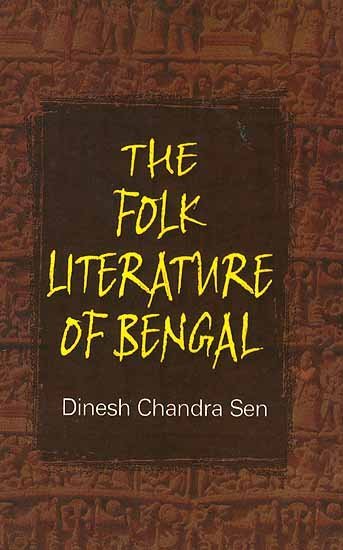Folk Tradition of Bengal (and Rabindranath Tagore)
by Joydeep Mukherjee | 2018 | 49,317 words | ISBN-10: 8186036989 | ISBN-13: 9788186036983
An English study regarding the Folk Tradition of Bengal and its influence on Rabindranath Tagore—an important Bengali polymath from the 19th century who excelled in philosophy, arts (painting), literature and music. This research tries to initiate the semantic aspect of “folk” through the help of various dictionaries....
Chapter 1.3 - Who are Bauls?
“What’s in a name” aptly stated by Shakespeare in his famous Romeo and Juliet though it is the ‘name’ only that leads one to fame. A Baul is not a Hindu or Muslim rather a man and beyond man a moner manush. They have no debate regarding ‘Quran’ and ‘Puran’. They met for the union of man and song. Their union stands for the union of ‘sur’ and ‘song’. Unmistakably Bauls are unanimous so far as their ‘name’ is concerned. They who are neither solely Muslim nor Hindu make Baul altogether. But Muslims of East Bengal [East Pakistan] and West Bengal are called ‘fakir’. ‘Fakir’ also contains indigenous names in different places. Somewhere they are called ‘nera’ (bald headed) ‘fakir’, somewhere they are called ‘be-shara’ ‘fakir’ or ‘masfati’/‘bedati fakir’. Bengali word ‘nera’ means a man with clean/shaved head. It was one of the rituals of Vaishnavism. Apparently it appears to be very confusing because being Muslim he/she follows the Hinduism without any yammering. It definitely incarnates the spirit of acceptance of all resources. Further the research tends to dig the history especially Pal dynasty because during that time Bangladesh became the hub of ‘Bauddhik upasana’. They were divided into two; the Mahayanas and Hinayanas. Innumerable riffraff were the followers. After the invasion, most of them were ‘shahadaed’(a term signifying the same what is called baptism in Christianity) into muslims. But surprisingly after such transformation they did not discard the old rituals though they were practically renounced by Hindu sect. Despite such sudden segregation from the society, they adhered to the age old customs of past religion although they are now known as ‘fakir’. As they still maintain Vaishanavite system of devotion, they are bare headed just like Buddha or Chaitnya Mahapravu. It is noteworthy that muslim contention of worship and Vaishnavite tradition on the other hand does not contradict and interrupt their swift process of progress. They are deeply impelled by the Sufi movement. Simultaneously they are sanely influenced by Chaitanya Mahapravu. But the balance is unmistakable. They are able to keep up the tone and temperament, the body and main gesture in relation to the method of signing.
A major portion of people living in the lower stratum of the society are really down trodden by elite Brahmins and as a result they used to live totally in the outskirt of common habituation. They took resort in Vaishnavite religion.They were sarcastically called ‘neraneri’ to identify their sudden shift from Buddhism to Vaishnavism. Birbhavara was the person for such tremendous transformation. Exceptions are also there even in muslim group of followers. For example ‘beshara’, ‘suariyat’ and others were reluctant to observe Islamic rituals.
Probing into the matter, the research can trace four types of theoretical bases among Muslim followers. They are respectively–‘Shariyat’, ‘Jarikat’, ‘Hakikat’ and ‘Marfat’. ‘Shariyat’ means unflinching belief in Islamic rituals propounded by Hazrat Muhammad. ‘Shariya’ is definitely a medium of communication with Allah and decides the internal as well as external sources. At the same time it is worth mentioning that it the process seldom emphasizes on its intrinsic realization or value. More or less it centres the following occasional aspects–‘Kalma’ (single minded faith in God or Allah), ‘Namaj’ (daily prayer), ‘Roja’ (starvation in the month of Ramjan), ‘Jakat’ (to emphasize the needy people) and ‘Hoj’ (pilgrimage) Makka. They conjecture these to be an indispensable part of mutual connection or devotion towards God.
‘Tarik’ is very common in the sense it frequently recurs in sufi and all branches of literature with the commutation of ‘patti’. In 8th and 9th century especially Muslim countries ‘Tarik’ was the path finder of his own as well others’ spiritual acclamation /culmination. But here also the path that it originally denotes is limited. Traditionally one has to go through, just like a murid [disciple], sadhan and bhajans as directed or decided by Murshid [guru]. It is believed that directed way by the Tarik is the ideal way for spiritual emblem.
‘Haraik’ is one who knows/perceives the real meaning of the essence of God. ‘Maufat’ on the other hand signifies ‘real knowledge’. Noticeably all the stages are the stages of escalation leading from one extreme of another. Here it evokes a sense ‘divyagyan’, the upper step of achieving absolute knowledge, a knowledge that makes him forgetful about his own existence and therefore leads him to the ultimate, the Almighty. In different terminology ‘touhid’ is the delusion about one’s own identity that also goads for divine enchantment. Hence, these types of ‘fakirs’ are called ‘marfati fakir’. On the other hand, sadhaks scattered in the entire parts of West Bengal belonging to Hinduism are called ‘Bauls’. Besides Rasik Vaishnav, ‘sadhakas’ like Rasik Pantha, Raganuga Panthi Vaishnav are extremely popular and significant considering their names known and typically designated according to the culture of different segments of West Bengal. Here ‘Rasik’ is a significant term bearing the load of their devotion, knowledge, forbearance and love. Vaishnav Sahitya is replete with these words. Random discussion with dictionary marks it as an enlightened man. It is stated one who succeeds typical ‘sadhana’ is called ‘Rasik’ or ‘Siddha Purush’. Interestingly no printed document consisting their theory and philosophy can be traced. Song is the only medium rather authentic document that is the be all and end all about their history of existence. Song is the mirror of their self revelation.
